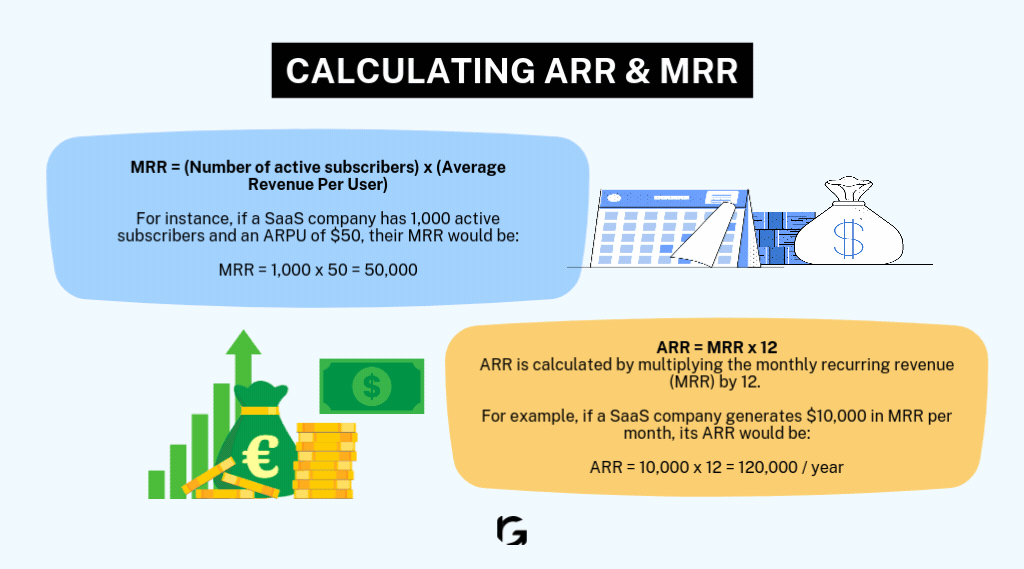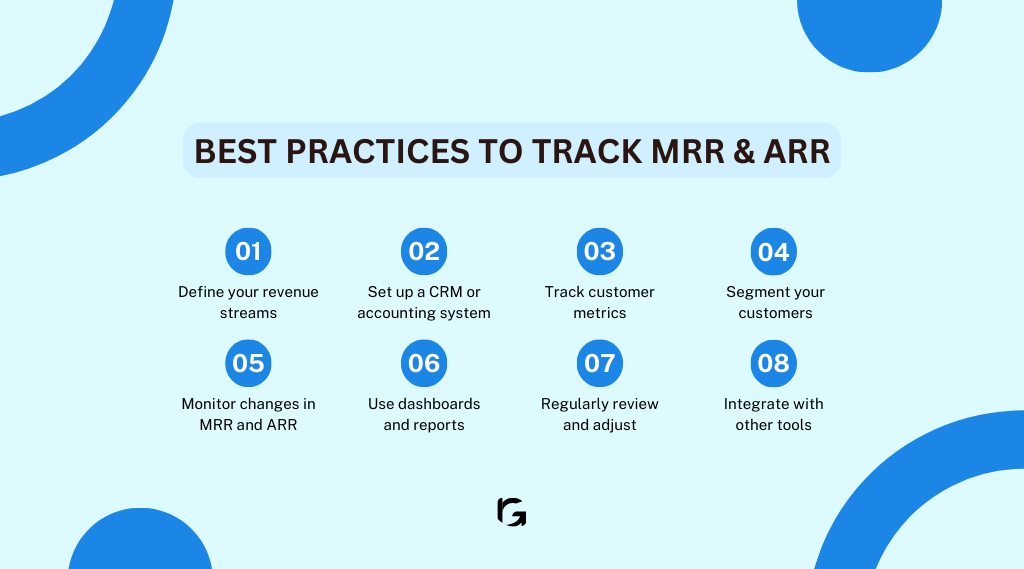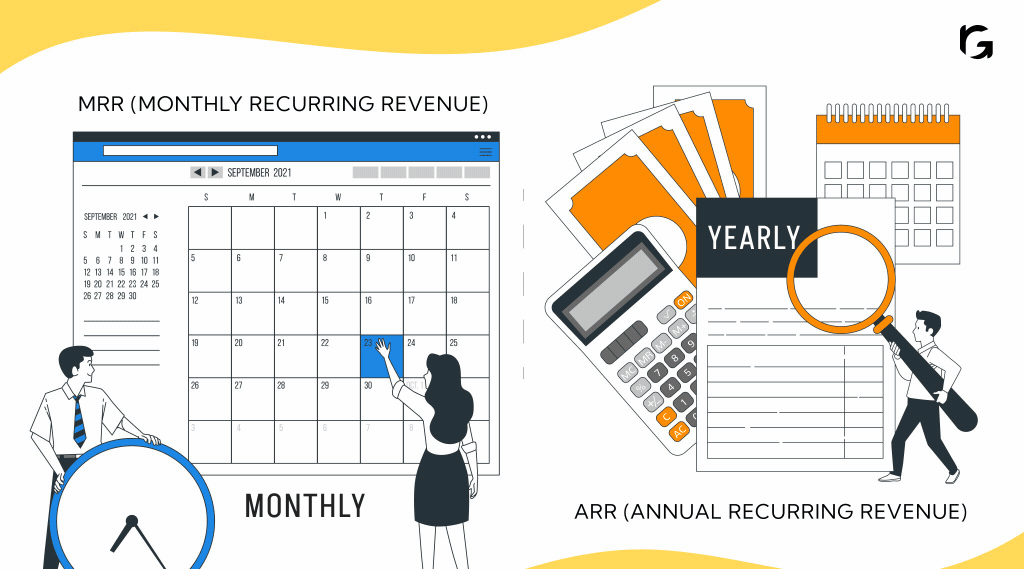Do you run a SaaS-based business? If yes, then you must be dealing with recurring payments and subscriptions, and perhaps, this is the reason why you are reading this post.
So, how do you slice and dice your recurring revenue? If you don’t have a robust framework for this, all you need to do is read this post till the end and we assure you that you won’t regret the time spent on doing so.
Understanding MRR & ARR
MRR (Monthly recurring revenue) is a key performance indicator (KPI) that measures the total revenue generated by a company every month from its subscription-based services. It is a critical metric as it enables entrepreneurs to monitor and track business growth along with identifying the current trends. Moreover, you can allocate your resources optimally and tweak pricing policies to ensure maximum revenue generation.
Similarly, ARR stands for Annual recurring revenue which is again a critical KPI to measure the “total value” of recurring revenue generated by a company on an annual basis. A growing ARR SaaS indicates a healthy and scalable business, while a stagnant or declining ARR may indicate issues with customer acquisition, retention, or pricing. But for most entrepreneurs, the question remains the same, “How to measure MRR and ARR growth?
Calculating ARR & MRR

MRR is typically calculated by multiplying the number of active subscribers by the average revenue per user (ARPU).
For example:
MRR = (Number of active subscribers) x (Average Revenue Per User)
For instance, if a SaaS company has 1,000 active subscribers and an ARPU of $50, their MRR would be:
MRR = 1,000 x 50 = 50,000
On the other hand, ARR is calculated by multiplying the monthly recurring revenue (MRR) by 12. Here’s the formula:
ARR = MRR x 12
For example, if a SaaS company generates $10,000 in MRR per month, its ARR would be:
ARR = 10,000 x 12 = 120,000 per year
For those unfamiliar with calculating “Average Revenue Per User” (ARPU). Here’s the formula for it:
ARPU = Total Revenue / Number of Active Users
Example:
Let’s say you’re a mobile game developer, and you want to calculate your ARPU for January.
Total Revenue: $10,000 (earned from in-app purchases and ads) Number of Active Users: 10,000 (users who played the game at least once during January)
Calculation:
ARPU = 10,000 / 10,000 = 1.00
Interpretation:
In this example, the ARPU is 1.00, which means that, on average, each active user generated $1.00 in revenue for January.
Types of MRR
There are different types of MRRs that you can consider tracking, depending on your current business requirements:
1. Gross MRR: The total revenue generated from new subscriptions.
2. Net MRR: The total revenue generated from new subscriptions minus any cancellations, churn, or downgrades.
3. Expansion MRR: The increase in revenue from existing customers, such as upgrades or additional features.
By tracking MRR, SaaS companies can gain valuable insights into their business performance and make data-driven decisions to drive growth and success.
Types of ARR
Here are some common types of ARR metrics:
1. Subscription ARR: This is the most common type of SaaS ARR, where customers pay a recurring fee for access to a product or service.
2. Usage-based ARR: This type of ARR is based on the level of usage or consumption of a product or service, such as data storage or bandwidth usage.
3. Tiered ARR: This type of ARR offers different pricing tiers or plans, allowing customers to choose the level of service that best fits their needs.
4. Tiered usage-based ARR: This type of ARR combines the concepts of tiered ARR and usage-based ARR, offering different pricing tiers based on usage levels.
5. Add-on ARR: This type of ARR involves offering additional features or services to existing customers, often at an additional cost.
Essence of ARR & MRR as Critical SaaS Metrics
Both ARR and MRR are the two most critical metrics for any SaaS business offering B2B or even B2C services. Let’s take a look at why most SaaS business owners often prioritize these metrics.
Why is ARR SaaS important for your business?
1. Revenue visibility: The ARR metric provides a clear picture of your company’s recurring revenue stream, helping you plan and make informed decisions about growth, investments, and resource allocation.
2. Growth tracking: By monitoring ARR, you can track your company’s growth over time, identifying trends, and making adjustments to optimize your business.
3. Competitive benchmarking: Comparing your ARR to industry peers and competitors helps you understand your market position and identify areas for improvement.
Why is MRR SaaS important for your business?
1. Cash flow management: MRR helps you manage your cash flow by offering a clear picture of your monthly recurring revenue.
2. Customer acquisition and retention: MRR is a key indicator of your customer acquisition and retention strategies, helping you identify areas for improvement.
3. Pricing and packaging: MRR helps you optimize your pricing and packaging strategies to maximize revenue and customer satisfaction.
Which metric to choose for your SaaS business? ARR or MRR?
To answer this precisely, if you are a startup, you need to monitor cash flow, make timely decisions, and track monthly revenue to take your business forward with actionable insights. Hence, starting with MRR will be a much better option for you.
ARR metric is best suited for businesses that have already gained a huge volume of subscribers and want to prioritize long-term planning, budgeting, and financial planning. Hence, adhering to ARR as a metric will be much more feasible for them.
Remember that both metrics are important and it’s not necessarily an “either-or” situation. You can use both ARR and MRR to gain a more comprehensive understanding of your business’s financial performance.
Best practices to track MRR and ARR

Now that you have gained enough insights into the essence of monitoring and tracking MRR and ARR growth for your SaaS business, let’s take a look at some best practices to implement these metrics for optimum results:
1. Define your revenue streams: Identify the different revenue streams in your SaaS business, such as subscription fees, add-ons, and one-time payments. This will help you accurately track MRR and ARR metrics.
2. Set up a CRM or accounting system: Utilize a Customer Relationship Management tool (Salesforce or HubSpot) or accounting software like QuickBooks, Xero, or Zoho Books to track customer information, invoices, and payments.
3. Track customer metrics: Monitor key customer metrics, such as:
- Customer acquisition cost (CAC)
- Customer lifetime value (CLV)
- Customer churn rate
- Average revenue per user (ARPU)
4. Segment your customers: Categorize customers into segments based on their subscription plans, industries, or geographic locations. This will help you identify trends and opportunities for future growth.
5. Monitor changes in MRR and ARR: Regularly track changes in MRR and ARR to identify trends, such as:
- Growth or decline in MRR and ARR metric
- Changes in customer acquisition and retention rates
- Impact of pricing changes or new product offerings
6. Use dashboards and reports: Create dashboards and reports to visualize your MRR and ARR data. This will help you quickly identify trends and make data-driven decisions.
7. Regularly review and adjust: Regularly review your MRR and ARR tracking to identify areas for improvement and adjust your strategies accordingly.
8. Integrate with other tools: Integrate your MRR and ARR tracking with other tools, such as:
- Sales and marketing automation platforms
- Customer support software
- Financial planning and budgeting tools
By following these best practices, you can easily track your MRR and ARR growth and make data-driven decisions to optimize your business for future growth and success.
The age-old confusion between ARR and bookings
Most SaaS-based companies are often confused between these two terms. Here’s a breakdown to help clarify the distinction:
ARR (Annual Recurring Revenue)
- ARR represents the total value of recurring revenue generated by a SaaS company on an annual basis.
- It’s the total amount of revenue a company expects to receive from its customers over a year, based on existing contracts and agreements.
- ARR is often used to measure the growth and stability of a company’s recurring revenue streams.
- It’s a key metric for investors, analysts, and stakeholders to evaluate a company’s financial performance and predictability.
Bookings
- Bookings represent the total value of new contracts or agreements signed by a company during a specific period, usually a quarter or a year.
- Bookings can include both new and upsold/cross-sold revenue, as well as any changes to existing contracts.
- Bookings are often used to measure a company’s sales performance, pipeline growth, and deal velocity.
- Bookings can be a leading indicator of future revenue growth, as they represent the total value of new business being signed.
Key differences:
- Timing: ARR is an annual metric, while Bookings are typically measured quarterly or annually.
- Scope: ARR focuses on existing contracts and agreements, while Bookings encompass new and upsold/cross-sold revenue.
- Purpose: ARR is used to evaluate a company’s financial stability and predictability, while Bookings are used to assess sales performance and pipeline growth.
Expert tips to elevate recurring subscription revenue
Elevating recurring subscription revenue requires a strategic approach toward customer acquisition, retention, and growth. Here are some expert tips to help you achieve this:
- Upraise the subscription rates: You must cautiously roof-test your current pricing and tweak the cost of your product/services for new customers. This is an agile approach toward increasing recurring revenue.
- Design pricing tiers: You can consider building pricing tiers to diversify your price points. Tiered pricing allows you to attract new customers through a lower entry point where you can also offer customized functionality to cater to diverse customer needs.
- Enhance adoption: Create a robust strategy to enhance your market share through advertisements, inbound marketing, and other tactics to drive customer acquisition. This will also buffer the churn that is an indispensable part of your subscription business.
- Adopt & promote expansion: Your customers must have a valid reason to invest more in your products/services. Think in terms of offering added features and functionalities, value-added services, and license seats.
- Focus on retention: Customer acquisition and retention are the two sides of your revenue coin. Think of creating opportunities to enhance loyalty in your customers through marketing, product offerings, deals & discounts, and through proactive customer service.
Endnote
Mastering MRR and ARR growth is crucial for any SaaS business looking to scale and sustain growth. By understanding the intricacies of MRR and ARR, you can make data-driven decisions to optimize your pricing strategy, customer acquisition, and retention efforts.
Revvgrowth helps SaaS businesses adopt the right marketing strategy, track performance & growth including critical metrics, and stay competitive while generating maximum revenues.
Ready to take your revenue growth to the next level? Talk to experts!
FAQs
1. How can I increase the MRR of my SaaS company?
To ensure enhanced MRR, you must prioritize retaining existing customers through loyalty programs and responsive customer service. You can consider upselling and cross-selling to these existing customers and try to improve the customer lifetime value (CLV) through an effective pricing and retention strategy.
2. What are some benefits of tracking ARR?
Tracking your SaaS company’s average recurring revenue comes with multiple benefits including revenue growth and financial stability, identifying the trends in customer preferences and behaviors, and making data-driven decisions. By tracking ARR, you can also optimize your pricing strategy and product development cycle.
3. How can I handle churns and cancellations?
First of all, start tracking churn rates and try to identify the reasons behind cancellations. Come up with a robust retention strategy to cut down the churn, and start with upselling and cross-selling to ensure reduced churns for your SaaS business.
4. What importance does ARR keep for investors?
As ARR is a long-term metric, it simply highlights your company’s long-term financial stability and progress. Investors get to know the strength of your top-line growth and make decisions accordingly to invest in your company.


